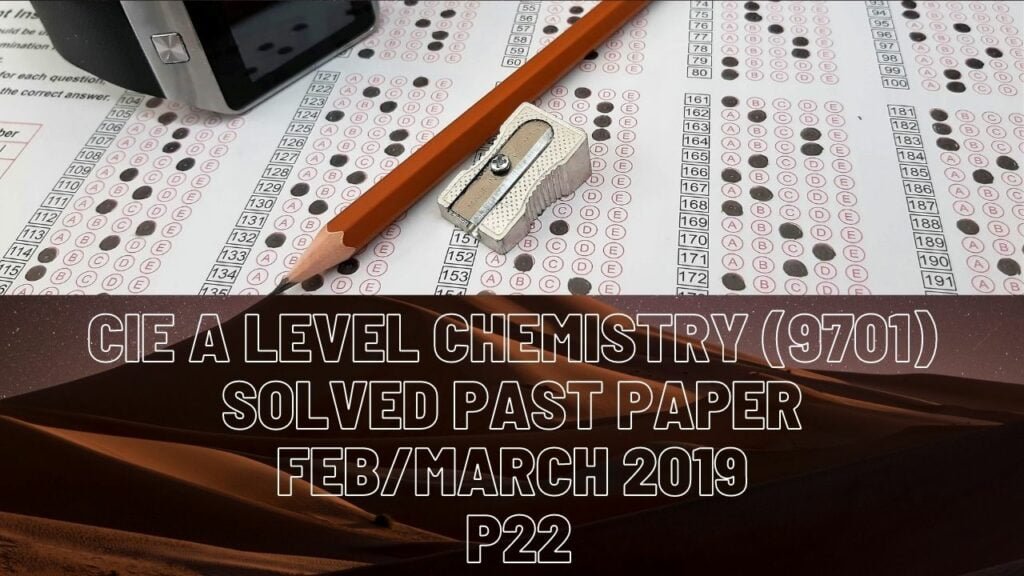
CIE A Level Chemistry Solved Past Paper Feb/March 2019 P22
1bi) The formula of magnesium nitride is Mg3N2, there are 3 atoms of Mg because of charge on nitride ion i.e -3 and number of nitrogen atoms are 2 since the magnesium ion has a charge of +2.
ci) Ammonium compounds can be used as fertlisers.
ii) CaO is a metal oxide thus is basic in nature. There is NH3 present in NH4Cl solution which is less basic than CaO, hence more basic one i.e CaO displaces NH3 from its solution i.e NH4Cl. This is displacement reaction where more reactive atom displaces less reactive atom from its solution.
dii) Thermal decomposition of Group I & II nitrates produce Group I and II oxides respectively, NO2 and O2.
iii) The most common mistake in these kind of Qs students tend to make is they take bond enthalpies of those bonds too which are not breaking at first place. Like in this Q, N?N bond is the one which is not breaking so enthalpy for bond breaking is just the enthalpy of breaking O=O and enthalpy for bond forming is 2 moles of N—>O forming.
e) Electrophilic addition reactions have C=C which are electron dense thus attracts partial positively species (i.e N=O in this Q) towards itself. When C=C breaks and that positively charged specie bonds to a carbon atom, the other carbon atom gets a positive charge which attracts partial negatively charged specie (i.e Cl in this Q). The intermediate of this reaction is second carbon atom with positive charge attracting the partial negatively charged specie that has a lone pair of electrons.
2 aii) F2 has temporary induced dipoles but H-Cl has got even stronger intermolecular attraction and that is permanent dipoles. H-Cl is a polar molecule where Cl- is a more electronegative ion than H+ while F2 has F-F where both ions are having the same electronegativities.
iii) Ionic or covalent bondings (intramolecular forces) are stronger than dipole-dipole interactions or hydrogen bonding (intermolecular forces) out there.
bi) Chlorine’s highest energy level has an unpaired electron in its 3p subshell whereas chloride ion (Cl-) has a complete valency.
ii) The stronger the oxidizing agent, the more it reduces in a chemical reaction. When Cl2 reacts with Fe, it reduces to -3. On the other hand, I2 reacting with Fe reduces to only -2 thus it concludes that I2 has less oxidizing power than Cl2.
ciii & iv)
| Ion | silver nitrate solution | dilute NH3 | concentrated NH3 |
| Chloride | white | dissolves | dissolves |
| Bromide | cream | insoluble | dissolves |
| Iodide | yellow | insoluble | insoluble |
cii) Cl2 + H2O ———> HCl + HClO
3a) Sodium, Na can be used to identify alcohol (gives off H2) and carboxylic acid (gives off CO2), 2,4-DNPH is exclusively used to identify carbonyl compounds (C=O & O=C-H) and acidified K2Cr2O7(aq) is an oxidizing agent which identifies primary and secondary alcohols by turning from orange to green precipitate.
b) LiAlH4 and NaBH4 are reducing agents.
c) R is a trans isomer meaning H atoms are across C=C so its stereoisomer is the one with both H atoms on the same side of C=C.
4 bii) Initiation: Cl2———-> Cl + Cl
Propagation: Cl + CH2=CHCH3 ———-> HCl + CH2=CHCH2 succeeded by CH2=CHCH2 + Cl2 ———-> Cl + CH2=CHCH2Cl
Termination: CH2=CHCH2 + Cl ———-> CH2=CHCH2Cl & CH2=CHCH2 + CH2=CHCH2 ———-> C6H10
iv) To turn alcohols to halogenoalkanes, PCl3 with heat, PCl5 or SOCl2 can be used.
ci) Breaking of C=C and formation of 2 new -OH bonds is a result of using cold dilute acidified KMnO4.
iv) H2O+strong dilute acid are conditions for both turning nitrile to carboxylic acid and acid hydrolisis (ester to carboxylic acid+alcohol).
d) Major product has Br attached to the second C atom from the left and that C atom is attached to only 1 H atom and 2 methyl groups which makes that a secondary carbocation when Br- separates from the structure. While minor product has Br attached to first C atom from the left and that C atom is attached to 2 H atoms and only 1 methyl group, that makes it a primary carbocation when Br- separates from the structure. Secondary carbocations are more stable than primary carbocations because of more positive inductive effect of alkyl groups that are electron donating groups.